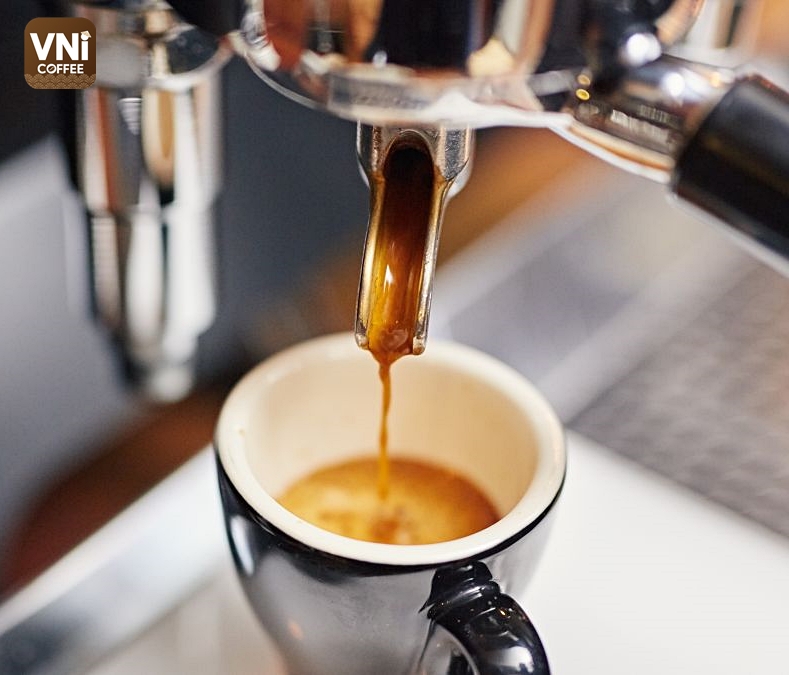
A jungle of Italian coffees to meet all the tastes
Although most coffee types come from South America, Italy is still considered this drink’s homeland since coffee has become a charming art and even culinary culture of the boot-shaped country. Italian coffee culture also spreads to other countries, which most people are familiar with the names Espresso, Mocha, or Cappuccino; however, that’s just part of the real abundance. A range of Italian coffees might get you overwhelmed looking at the menu. No worry, we’re here to help you define the difference between the most common coffee types from Italy so that next time you can decide the best one for yourself without any confusion.
1. Espresso
Appeared in1884, Espresso has become one of the most popular Italian coffees today. The word Espresso in Italian means “make it quickly” – that is, you need to pour boiling water fast and strongly down a layer of compressed coffee powder, then through a filter into a warmed cup. A qualified cup of Espresso should have a yellow-brown foam (crema) layer on the surface, bitter and strong taste due to the high caffeine. This type of coffee is usually served in a thick cup with a capacity of about 40ml. In Italy, when you order a regular cup of coffee, without a specific name, the waiter will automatically give you an Espresso treat.
Espresso is also the basis for baristas to unleash their creativity to
make other delicious drinks such as Cappuccino, Latte, Americano, etc.
2. Americano
Americano is basically a type of coffee that is modified from Espresso by adding hot water to it. Contrary to its predecessor, Americano is sweet, low in caffeine without the sour taste of Arabica beans, and also served in a bigger cup. To get a true Americano, baristas often apply in the ratio of 1 shot of Espresso (25-30ml) and 5-6 oz of boiling water. It can be said that this Italian coffee is quite similar to a typical American coffee that always comes in a large portion but has a weak flavor. Therefore, if you think Espresso is too strong and the small cup is not enough for you, just go for Americano!
3. Cappuccino
Cappuccino is also made from Espresso but is more popular and is usually served in the morning in thick stone or porcelain cups. A standard Cappuccino is a combination of three ingredients in equal proportions: hot milk, milk foam, and Espresso mixed with twice the amount of water. On top of the foam layer will be sprinkled with a little cinnamon powder or cocoa powder to enhance the taste; at the same time, the barista uses a spoon or mold to make art on this layer.
4. Latte
Latte in Italian means coffee and milk. Due to the same ingredients, Latte is often confused with Cappuccino. In fact, if Cappuccino is made by using Espresso mixed with whey or cream and adding cinnamon or cocoa powder, Latte is processed by mixing Espresso with milk under high pressure, so Latte usually has less foam. The type of milk used to make Latte in Italy is usually whole milk embracing lots of creaminess. Originally, this Italian coffee was created specifically for children because of its richness and low caffeine content. But then, with the attractive taste, it became more popular with all ages.
5. Mocha
Mocha is an Italian coffee made from Espresso and hot milk, with a little chocolate flavor (chocolate powder or chocolate sauce). The sweetness of chocolate blending perfectly with the moderate bitterness of Espresso and the greasy taste of hot whipped milk foam creates an attractive coffee flavor loved by most women and young people. This Italian coffee has two types: iced mocha and hot mocha. While hot Mocha is attractive with a strong aroma, iced Mocha with crushed ice is mixed in coffee to make us comfortable with the cold taste.
6. Macchiato
Macchiato is a form of Espresso coffee with a layer of steamed milk poured quickly on top. Although the process sounds rather simple, to have a perfect cup of Macchiato, the barista needs to practice hard to get the precise ratio. Macchiato comes in two variations: Espresso Macchiato and Latte Macchiato. Espresso Macchiato favors a characteristic bitter taste, while Latte Macchiato makes an indelible mark with a greasy sweetness from the milk.
7. Shakerato
Shakerato is a very familiar cold drink of Italians in the summer. The Shakerato recipe is also simple: add 1 shot of Espresso, ice cubes, and a few teaspoons of sugar or syrup into a cocktail shaker, shake until frothy and pour into a martini glass or an elegant drinkware. Shaking Espresso with ice and sugar creates a wonderful texture, mellowed and creamy with a certain viscosity.
8. Marocchino
Marocchino is a delicate cocktail of cocoa powder, frothed milk, and Espresso, in a small transparent cup. The ingredient classes in a cup of Marocchino are divided into many specific layers: Espresso as a base – a layer of cocoa powder – milk froth or cream – and another cocoa powder dusting. The Marocchino contains an intense, sweet flavor, suitable for those who like thick chocolate taste with a light coffee flavor. You can either add sugar to it or not, depending on the flavor of the cocoa powder you used.
9. d’Orzo
With caffeine-free, d’Orzo is a popular Italian beverage among children and decaf coffee lovers. This coffee is a type of hot drink made from roasted ground barley, which means it’s completely not a drink of Espresso or any coffee type at all; therefore, it has a good smell of barley grain with a slightly bitter taste. You are likely to find d’Orzo at some vending machines in Italy.
10. Freddo
Freddo is another espresso-based coffee put on the top list during hot summer days. It is served with a standard Espresso and a glass of ice. Then, you will need to pour the coffee on top of the ice and wait a few minutes before enjoying it. It’s necessary to notice the ratio of coffee and ice cubes; don’t take too much ice unless you want a diluted beverage.
11. Corretto
The Italian coffee Corretto is made by adding to the ordinary Espresso some drops of strong liquid, typically grappa, sambuca, etc. After ordering a cup of Espresso, you can specify the type of alcohol you want to drip into your coffee. In case you are a regular customer, the baristas will gladly let you make your own dose by providing a cup of Espresso along with a bottle of your favorite booze.
Facts about how Italian enjoy coffees
- Every Italian coffee type will be served in its kind of glass or cup, no exception.
- To order a Latte, you’d better say Caffe Latte, or the waiter will give you just a simple glass of milk.
- Italians normally enjoy their coffee at the bar, quickly and enough, which means the bar in Italy is merely a place to have a coffee but not alcohol. Also, you will not find any take-away cups here.






